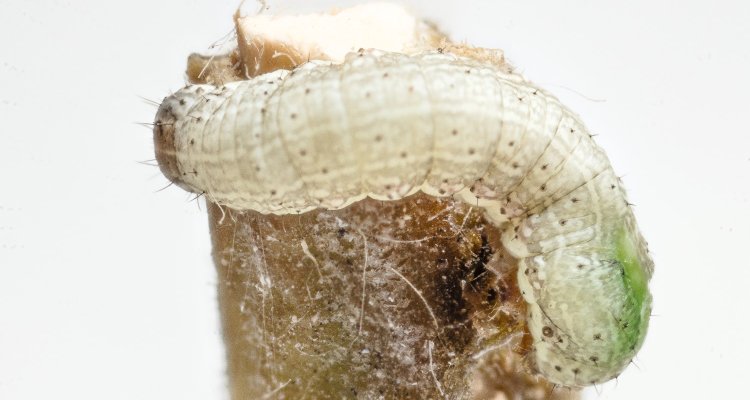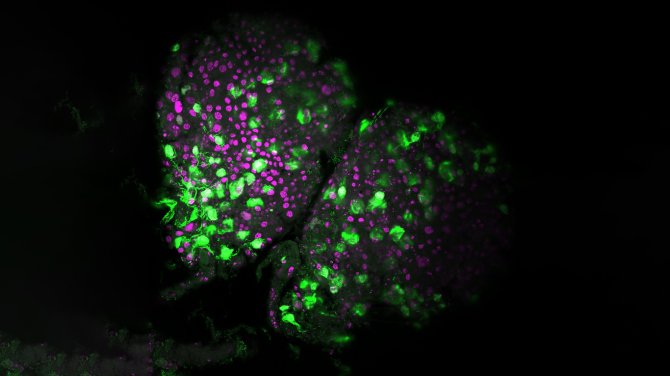
News
Baculoviruses need little help to infect caterpillar brain
When baculoviruses invade a caterpillar's central nervous system, the caterpillar has little defence. Therefore, the parasite is also used as a biological crop protection agent. Simone Nordstrand Gasque investigated how a behaviour-changing member of this virus family gains access to a caterpillar's brain. It seems to do so differently than expected, she concluded. The findings have been published in the scientific magazine Open Biology.
Baculoviruses are used as biological crop protection agents to protect agricultural crops from caterpillar infestations. Some members of this virus family are known to attack only the specific pest insect and leave other insects unaffected. At the Wageningen laboratories of Virology and Entomology, Simone Nordstrand Gasque investigated how the baculovirus named AcMNPV invades the central nervous system of the beet armyworm. This pest insect is fond of a wide range of vegetable and flower crops and can cause a lot of damage worldwide.
Diffusion through tracheae
Before starting at university, Gasque was triggered by a documentary on parasites infecting humans. Her fascination has remained, although it has shifted to parasites that change the behaviour of the host they infect. Baculoviruses are special because they are well protected against UV radiation and therefore manage to survive well in nature. In this study she investigated the central nervous system and the trachea linked to it. She tracked the virus infection over time: "The infection happens from cell to cell in the trachea, the breathing tubes, of the insect. That makes sense because these cells reach and branch within the brain. Arriving at the brain, the virus encounters a blood-brain barrier that protects the brain from infection. This virus manages to cross that barrier."

PTP enzyme not required
Previous studies seemed to suggest that the virus needs help from a particular protein it encodes to get into the brain. This is the PTP enzyme, an enzyme that has been found in previous studies to be needed for the expression of the hyperactivity. As this enzyme does its work, the virus gains access to the brain; that was the hypothesis. As a result, the caterpillar starts behaving hyperactively. As the insect becomes hyperactive, it starts moving more horizontally through the crop and the virus spreads further. Gasque infected the caterpillars with different virus mutants which encoded different versions of PTP, or not at all. She came to a surprising insight: "It turned out that the PTP enzyme was not needed for the virus to enter the caterpillar's central nervous system. Whether the enzyme was active or not, or not even present in the genome of the virus, the virus managed to infect the brain. This immediately leads to a new question: what mechanisms are behind the behavioural change?"
Related to movement
Detailed microscope images also showed the locations in the caterpillar's brain where the virus was found. According to Gasque, that also provided interesting information: “We saw the virus locate at multiple areas of the brain and the central nervous system. One spot I am specifically curious about is in the middle of the brain. This is close to an area that is involved with spatial information on movement control, and in other studies this area is suggested to be the area for motivation of movement. This could indicate that the caterpillar's hyperactivity is caused by the location of the virus in the brain. Based on this study, we are far from knowing for sure, but it is a valuable new piece of the puzzle."
Starting points for follow-up research
The specific baculovirus (AcMNPV) that Gasque worked with is one of many members of the virus family. Whereas this species threatens, conservatively estimated, at least 30 caterpillar species, other baculoviruses are only dangerous to one or a few caterpillars. "So if you want to use these viruses for crop protection, you have to know exactly which virus you need to control a specific caterpillar. Through this kind of research, we are finding out more and more about how these viruses affect the behaviour of caterpillars. Although my research is not directly suitable for practical application, it does provide starting points for future research into concrete applications."